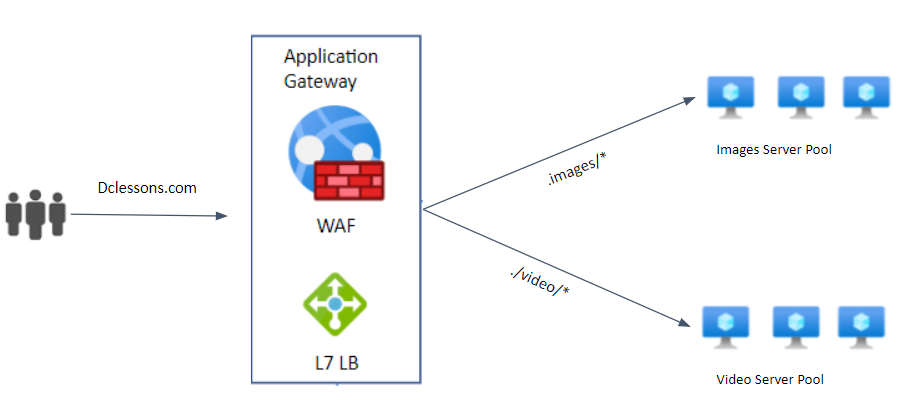EMAIL SUPPORT
dclessons@dclessons.comLOCATION
USAzure Application Gateway
Azure Application Gateway is a web traffic load balancer that enables you to manage traffic to your web applications.
Application Gateway can make routing decisions based on additional attributes of an HTTP request, for example URI path or host headers. For example, you can route traffic based on the incoming URL. So if /images is in the incoming URL, you can route traffic to a specific set of servers (known as a pool) configured for images. If /video is in the URL, that traffic is routed to another pool that's optimized for videos.

This type of routing is known as application layer (OSI layer 7) load balancing. Azure Application Gateway can do URL-based routing and more.
Azure provides a suite of fully managed load-balancing solutions for your scenarios.
- If you're looking to do DNS based global routing and do not have requirements for Transport Layer Security (TLS) protocol termination ("SSL offload"), per-HTTP/HTTPS request or application-layer processing, review Traffic Manager.
- If you need to optimize global routing of your web traffic and optimize top-tier end-user performance and reliability through quick global failover, see Front Door.
- To do transport layer load balancing, review Load Balancer.
Azure Application Gateway V2
Application Gateway is available under a Standard_v2 SKU. Web Application Firewall (WAF) is available under a WAF_v2 SKU. The v2 SKU offers performance enhancements and adds support for critical new features.
The new v2 SKU includes the following enhancements:
- Autoscaling: Application Gateway or WAF deployments under the autoscaling SKU can scale out or in based on changing traffic load patterns. Autoscaling also removes the requirement to choose a deployment size or instance count during provisioning. This SKU offers true elasticity. In the Standard_v2 and WAF_v2 SKU, Application Gateway can operate both in fixed capacity (autoscaling disabled) and in autoscaling enabled mode. Fixed capacity mode is useful for scenarios with consistent and predictable workloads. Autoscaling mode is beneficial in applications that see variance in application traffic.
- Zone redundancy: An Application Gateway or WAF deployment can span multiple Availability Zones, removing the need to provision separate Application Gateway instances in each zone with a Traffic Manager. The backend pool for applications can be similarly distributed across availability zones.
- Static VIP: Application Gateway v2 SKU supports the static VIP type exclusively. This ensures that the VIP associated with the application gateway doesn't change for the lifecycle of the deployment, even after a restart.





LEAVE A COMMENT
Please login here to comment.